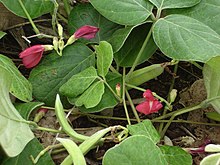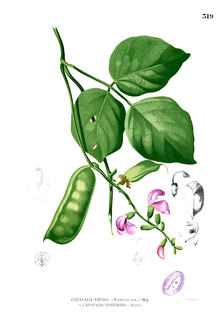Canavalia
| Canavalia | |
|---|---|

| |
| Scientific classification | |
| Kingdom: | Plantae
|
| (unranked): | Angiosperms
|
| (unranked): | |
| (unranked): | |
| Order: | |
| Family: | |
| Subfamily: | |
| Tribe: | |
| Genus: | Canavalia |
| Species | |
|
about 50, see text | |
| Synonyms[2] | |
| |
Canavalia is a genus of flowering plants in the legume family (Fabaceae) and comprises approximately 48[3] to 50[4] species of tropical vines. Members of the genus are commonly known as jack-beans. The species of Canavalia endemic to the Hawaiian Islands were named ʻāwikiwiki by the Native Hawaiians. The name translates to "the very quick one"[5] and comes from the Hawaiian word for "fast". The genus name is derived from the Malabar word for the species, kavavali, which means "forest climber."[6]
Uses[]
Several species are valued legume crops, including common jack-bean (C. ensiformis), sword bean (C. gladiata) and C. cathartica. At least the first makes a beneficial weed- and pathogen-suppressing living mulch.[7] The common jack-bean is also a source of the lectin concanavalin A, which is used as a reagent in glycoprotein biochemistry and immunology. The jack-bean is also a common source of purified urease enzyme used in scientific research.
The bay bean (Canavalia rosea) is supposedly mildly psychoactive when smoked, and is used in tobacco substitutes.
Ecology[]
Some animals have adaptations to the defensive chemicals of jack-beans. Caterpillars such as that of the two-barred flasher (Astraptes fulgerator) are sometimes found on Canavalia. The plant pathogenic ascomycete fungus was described from a jack-bean. Introduced herbivores have wreaked havoc on Canavalia on the Hawaiian Islands and made some nearly extinct; it may be that these lost their chemical defenses because no herbivorous mammals existed in their range until introduced by humans. The usually bright pea-flowers are pollinated by insects such as solitary bees and carpenter bees such as .
History[]
The genus name Canavalia was, as recently as 1913, known as Canavali.[8]
Diversity[]


Species include:[9]
|
|
Formerly placed here[]
- (Wall. ex Benth.) Prain (as C. grandis (Wall. ex Benth.) Kurz)[10]
Gallery[]
See also[]
- Thierry Bardini - researched Venezuelan jack-bean agriculture early in his career
References[]
| Wikimedia Commons has media related to Canavalia. |
| Wikispecies has information related to Canavalia. |
- ^ de Queiroz LP, Pastore JF, Cardoso D, Snak C, de C Lima AL, Gagnon E, Vatanparast M, Holland AE, Egan AN (2015). "A multilocus phylogenetic analysis reveals the monophyly of a recircumscribed papilionoid legume tribe Diocleae with well-supported generic relationships". Mol Phylogenet Evol. 90: 1–19. doi:10.1016/j.ympev.2015.04.016. PMID 25934529.
- ^ Jump up to: a b "Genus: Canavalia Adans". Germplasm Resources Information Network. United States Department of Agriculture. 2007-10-05. Archived from the original on 2011-06-05. Retrieved 2010-12-03.
- ^ Sridhar, K. R.; et al. (2005). "Biochemical and biological evaluation of an unconventional legume, Canavalia maritima of coastal sand dunes of India" (PDF). Tropical and Subtropical Agroecosystems. 5 (1): 1–14.
- ^ Yamashiro, A.; Yamashiro, T. (2008). "Utilization on extrafloral nectaries and fruit domatia of Canavalia lineata and C. cathartica (Leguminosae) by ants". Arthropod-Plant Interactions. 2 (1): 1–8. doi:10.1007/s11829-008-9030-y. S2CID 40061101.
- ^ Pukui, M. K., et al. (1992): New Pocket Hawaiian Dictionary with a Concise Grammars and Given Names in Hawaiian. University of Hawaii PRess, Honolulu. ISBN 0-8248-1392-8
- ^ Austin, D. F. (2004). Florida Ethnobotany. CRC Press. p. 161. ISBN 978-0-8493-2332-4.
- ^ Caamal-Maldonado, J. A.; et al. (2001). "The use of allelopathic legume cover and mulch species for weed control in cropping systems". Agronomy Journal. 93: 27–36. doi:10.2134/agronj2001.93127x. Archived from the original on 2014-05-25. Retrieved 2013-08-29.
- ^ Piper, C. V. 1913. "The Jack Bean and the Sword Bean." USDA Bureau of Plant Industry, Circular. No. 110. p. 29-36
- ^ Genus Canavalia. Archived 2014-05-17 at the Wayback Machine International Legume Database & Information Service (ILDIS). Version 10.01, November 2005. Retrieved 17 December 2007.
- ^ Jump up to: a b "GRIN Species Records of Canavalia". Germplasm Resources Information Network. United States Department of Agriculture. Archived from the original on 2009-01-20. Retrieved 2010-12-03.
- ^ Jump up to: a b c d e f "ʻawikiwiki, puakauhi". Hawaiian Ethnobotany Database. Bernice P. Bishop Museum. Archived from the original on 2007-07-02. Retrieved 2009-03-26.
- ^ "Canavalia galeata". Hawaiian Native Plant Propagation Database. University of Hawaiʻi at Mānoa. Retrieved 2009-03-26.
External links[]
- Canavalia
- Fabaceae genera
- Phaseoleae
- Taxa named by Michel Adanson




